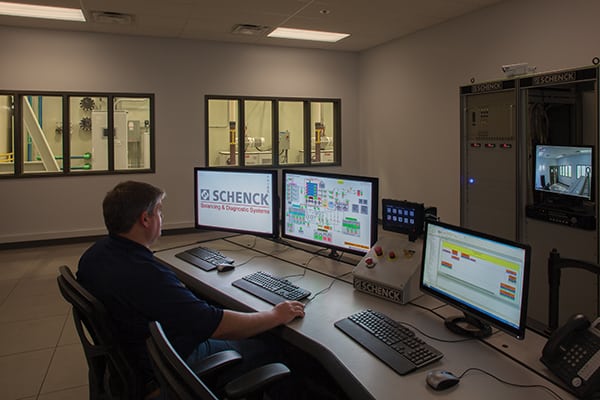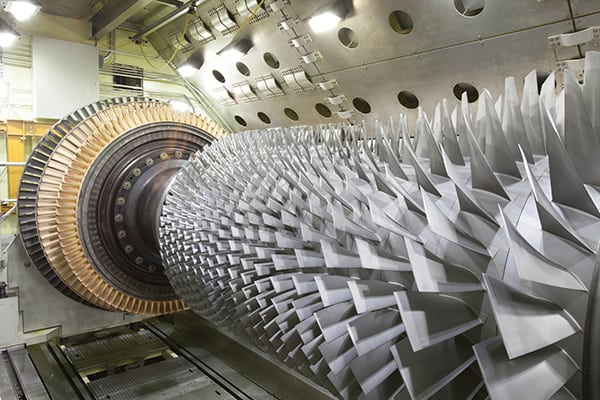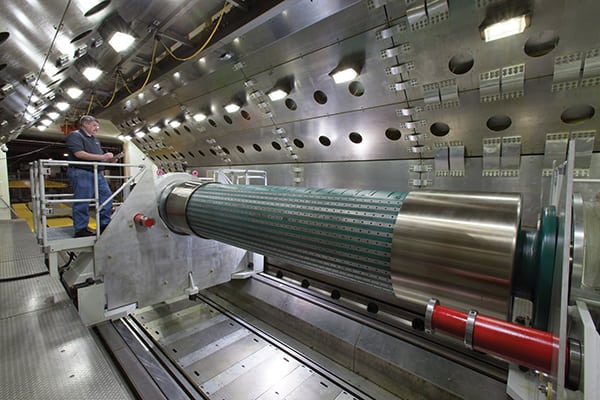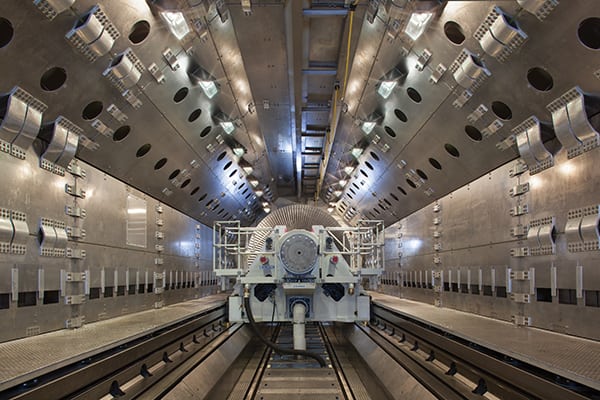High-Speed Turbine Rotor Balancing Lowers Costs and Improves Operation
High-speed turbine rotor balancing was once rare because of the costs and logistical challenges involved in doing it during an outage. That’s begun to change as economic options emerge, and experience is showing that high-speed balancing can pay big dividends in reliability and maintenance costs.
To a maintenance engineer or fleet manager, unwanted vibration in a turbine or generator is like a mosquito buzzing around the room on a hot summer night: annoying and elusive. But unlike a mosquito, unwanted vibration can be expensive in terms of extra wear and tear on rotating parts, and it can lead to added cost in the form of an unexpected outage.
That’s why performing a high-speed balance on steam and gas turbines and generator rotors is increasingly accepted as a vital aspect of a generating unit’s maintenance routine. A high-speed balance helps ensure reliable turbine operations, an important advantage in competitive power markets that demand extreme unit cycling (Figure 1).
In the past, rotor balancing was only performed at low speeds. That’s because steam turbine rotors were typically repaired either on-site or in a facility that lacked access to a high-speed balance cell. In addition, original equipment manufacturers (OEMs) only on occasion would recommend a high-speed balance.
This approach, however, is not necessarily the best option. That’s because relying on a low-speed balance can cause maintenance engineers to miss issues that surface only when the machine is run under full-speed conditions. Power plant professionals know, for example, that in some generator rotors, turn-to-turn shorts are noticeable only at or near rated speed. As a result, if the machine is not high-speed balanced before it returns to full operation, undetected faults can cause vibrations. In a worst-case scenario, these vibrations can damage rotating parts and even force an unplanned outage.
This factor recently came into play for a regulated utility in Wisconsin. The utility elected to perform high-speed balancing and run its generating units with vibration levels even lower than what was specified by the OEM. Its maintenance engineers reported that the high-speed balance meant fewer problems with bearings and hydrogen seals in particular, and with all other major parts in general. They found that lower vibration reduced unit wear and tear, which in turn reduced overall maintenance expenses.
Customer-Driven Demand
The increasing demand for high-speed balance services is largely customer driven and stems in part from frequent unit cycling. Consider that liquid-cooled units rated at 400 MW and larger were neither designed nor intended to cycle. But market changes and regulatory mandates have shaken up unit dispatch orders, in some cases to favor renewable energy resources during their peak availability. As a result, some formerly baseload units cycle as often as twice a day.
In addition, spark spreads in many markets may favor natural gas generation one day and coal the next. This near–price parity also factors into unit-cycling decisions. Whether it’s to comply with regulatory mandates or in response to fuel price signals, unit cycling leads to increased maintenance issues.
Although high-speed balancing can potentially help minimize maintenance issues, it still has not become an integral part of power generator maintenance outage planning. This is largely because service centers have not been available to perform high-speed balancing operations quickly and efficiently.
One reason for this gap is that many OEM service shops are sited regionally. At the same time, a central factory controls the OEM’s high-speed balance cell, but it typically operates as a separate organization. This two-track structure makes it logistically difficult during an outage to ship generators and rotors from the service shops to the factory and then back to the power plant in a timely and cost-effective way. Because of these challenging logistics, many OEMs simply do not recommend high-speed balancing at the end of a maintenance outage.
High-Speed Balancing Options
However, improvements are being made in this area, and practical experience is leading many power plants to reconsider past practices. Operators are frequently electing to perform a high-speed balance on their generator rotor prior to returning the unit to service. In some cases, the balancing is done on-site. While this option works, it is rarely optimal. On-site balancing can be time-consuming and costly, especially considering the gassing and de-gassing that must take place along with the multiple run-ups of the power plant that may be required as the balance is performed.
Technological advances, however, now enable what is in many cases a cost-effective alternative. A state-of-the-art balance facility can include both vacuum capability as well as the ability to excite generator rotors at high speed. These features allow the testing and balancing of steam turbines, gas turbines, and generator rotors.
For example, at MD&A’s high-speed balance facility in St. Louis, Mo. (Figure 2), rotors can be turned in a high-tech vacuum chamber at speeds of up to 4,320 rpm. Through a speed increaser, the facility can also handle other rotating equipment at speeds of up to 12,000 rpm.
 |
|
2. In control. With four high-definition cameras mounted in the balance facility, engineers can receive measurements digitally and also observe real-time operation. Courtesy: Sam Fentress Photography |
Using this technology can minimize impact on a generating unit’s outage cycle. In most cases, only two or three days are required to fully test and balance a unit. From a cost standpoint, completing the high-speed balance when the machine is in the shop, versus after a separate transportation cycle, can be attractive. As a result, performing both the repair and balancing of a turbine rotor or generator field at one location means that the machine will be able to come back online faster.
Fast Turnaround
A typical repair cycle for a generator rotor involves pulling it from the stator and transporting it to a maintenance facility. If the rotor is scheduled for a full rewind, the cycle can last from 20 to 30 days, depending on the generator size. A high-speed balance takes place at the end of the repair cycle. If it’s just a matter of testing and inspecting the unit, the cycle can be shortened to under 10 days, including transportation, in-shop inspection, high-speed balance, and return transport to the site.
Shaving days off of an outage can be especially important when regulatory review is considered. One utility reported that if it was able to take its unit offline and return it to full load within a certain number of days, then the regulatory review of the outage would be much more favorable. So though the unit spent an additional two days in the shop for high-speed balancing, the operator was still able to return it to service a full week ahead of schedule and meet the regulatory incentive.
Additional Advantages
A high-speed balance offers at least two other advantages. First, for both turbine rotors and generator fields, all the major components can be tested under rigorous conditions. That means applying the greatest centrifugal force that the components are likely to experience during their service lives, which allows the machine to be precision-balanced to a fixed base point (Figure 3). By contrast, if the operator were to complete only a low-speed balance and then take the unit to speed, some change in the balance is likely to occur, introducing vibration and greater wear and tear.
 |
|
3. Reduced vibration. High-speed balancing allows for effective testing to ensure minimal vibrations in any manufacturer’s rotor. Courtesy: Sam Fentress Photography |
Second, full electrical testing can be completed on the generator field as it runs at speed. One problem that operators typically face with their generator rotors is shorted turns, which can lead to changes in vibration with load due to thermal action as the parts heat up. Performing a high-speed balance on a generator rotor provides the opportunity to perform a flux probe test. This extremely beneficial test helps ensure that there are no shorts at speed once the unit returns to service. Doing a flux test is an advantage, because any number of short turns can escape detection in the wind shop simply because they aren’t detectable when the unit is at standstill. This makes it essential for testing to be done at speed, and the only way to do that is with a high-speed balance.
A second type of test in addition to flux probe is thermal testing, also referred to as a heat run (Figure 4). In this test, technicians bring the unit up to full speed and then apply current to the windings. This allows the technician to assess the quality of the windings in terms of their ability to grow symmetrically with load. Only a few facilities in the country can conduct this specific test.
 |
|
4. Heat run. A full high-speed thermal test, or heat run, excites generator fields at speed to assess the quality of the windings. Courtesy: Sam Fentress Photography |
Cost Considerations
Data provided by various utilities shows that the cost of a high-speed balance is less than the cost of one individual roll-up at site in terms of time, fuel, and lost power production. One Ohio-based utility reported that it cost roughly $180,000 per run-up on a restart from an outage. In contrast, facilities that utilize high-speed balance technology, even including thermal testing, typically report much lower costs, in addition to increased efficiency.
It’s important to note that even after a high-speed balance, a unit still may experience vibration issues. This is because units running in their full train have different mode-shapes and forces acting on them, and these forces differ from what the machines are subjected to in the single-span configuration in the high-speed balance cell.
In addition, unit-specific alignment and coupling hardware exists only on-site. Operators still may need to perform some trim balancing after a high-speed balance to account for these machine-specific components. That final detail work, however, should be relatively minor compared to what staff would otherwise have to do, had the items not been high-speed balanced, and experience suggests that a trim shot is rarely required.
Growing Demand for Balancing
Demand for high-speed balancing is growing among operators of larger gas-fired units. These machines are increasingly taking on baseload duties or are serving as primary load-following units in combined cycle markets. Reliance on these machines as the backbone of many utility generating fleets makes it more important than ever to ensure their smooth, reliable operation.
This process is proving to have measurable positive effects throughout the industry. For example, one utility in the Southeast had its 7FH2 generator down for a major gas turbine and generator overhaul. Upon inspection, shorted turns and some coil migration were observed in the equipment. Based on that evaluation, the utility elected to pursue a full rewind along with full electrical testing and a high-speed balance.
At the same time, the utility also elected to complete a high-speed balance on its 7FA gas turbine rotor, which is a fairly unusual practice. Most gas turbines are low-speed balanced when they are manufactured and typically do not undergo high-speed balancing after repairs. But the utility had time in the outage schedule, so the turbine was transported for maintenance and then run up to full speed for balancing. Engineers noted changes in the low-speed balance after the unit was brought to 3,600 rpm for the first time. After balancing out those changes and reducing vibration to levels below acceptable OEM specs, the machine was returned to the utility. The utility restored the generating unit to service and reported it to be the smoothest running machine in its fleet.
Though it is a newly embraced concept, high-speed balancing can ultimately extend the lifetime of equipment while also helping power generators save money and time and improve reliability. Just as you sleep better in a mosquito-free room, your maintenance team will rest easier without the worry of nagging and persistent vibration. ■
—Keith Collins ([email protected]) manages balancing of rotors for generators, steam turbines, gas turbines, large motors, and boiler feed pump turbines at MD&A.
